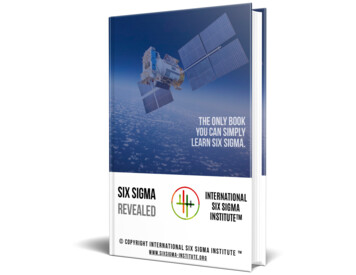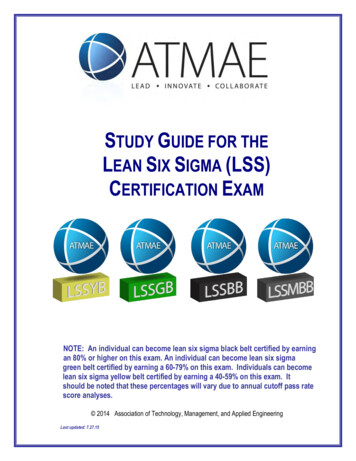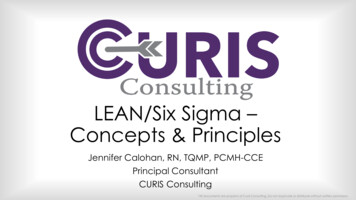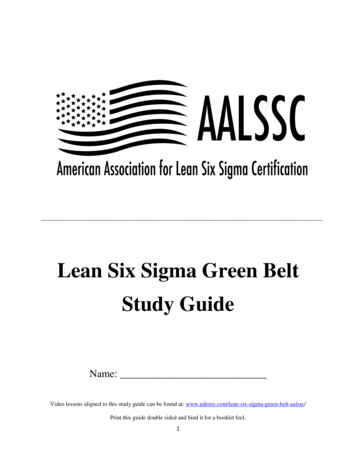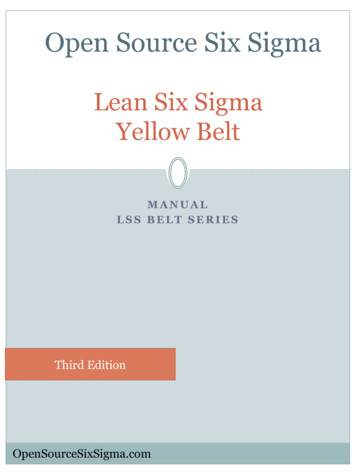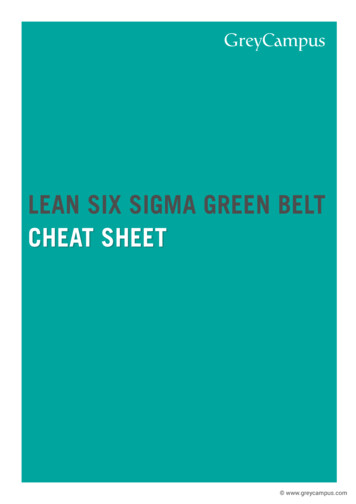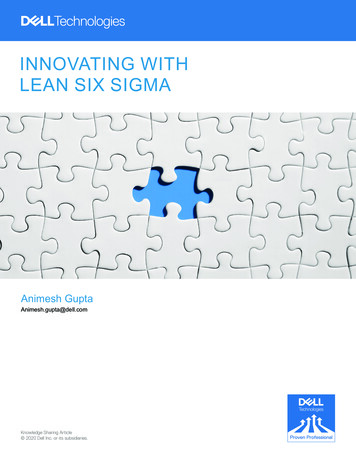
Transcription
INNOVATING WITHLEAN SIX SIGMAAnimesh GuptaAnimesh.gupta@dell.comKnowledge Sharing Article 2020 Dell Inc. or its subsidiaries.
The Dell Technologies Proven Professional Certification program validates a wide range of skills andcompetencies across multiple technologies and products.From Associate, entry-level courses to Expert-level, experience-based exams, all professionals in or looking tobegin a career in IT benefit from industry-leading training and certification paths from one of the world’s mosttrusted technology partners.Proven Professional certifications include:CloudConverged/Hyperconverged InfrastructureData ProtectionData ScienceNetworkingSecurityServersStorageEnterprise ArchitectCourses are offered to meet different learning styles and schedules, including self-paced On Demand, remotebased Virtual Instructor-Led and in-person Classrooms.Whether you are an experienced IT professional or just getting started, Dell Technologies Proven Professionalcertifications are designed to clearly signal proficiency to colleagues and employers.Learn more at www.dell.com/certification2020 Dell Technologies Proven Professional Knowledge Sharing2
Table of ContentsUnderstanding the value . 4Six Sigma. 4What is Six Sigma?. 4The 5-key principle of Six Sigma . 4Six Sigma Methodology . 6Six Sigma process of business transformation . 6Six Sigma Techniques . 8The Six Sigma Tools . 9Lean Methodology . 10What is Lean? . 10What is “Value”? . 10Removing Waste . 11The Five Principles of Lean . 12Introduction to Lean tools. 13Experiencing Change with Lean Six Sigma . 13Why is Lean Six Sigma gaining the importance in today’s scenario? . 14Final Takeaway . 14References. 15Disclaimer: The views, processes or methodologies published in this article are those of the author. They donot necessarily reflect Dell Technologies’ views, processes or methodologies.Dell.com/certification3
Understanding the valueComputerized change has become the sultriest trendy expression of this decade. It is the utilization of new,quick and changing advanced innovation to address pressing issues.New innovations and apparatus are supporting the change excursion of organizations large and small, as theycompete to get a greater cut of business in a fast-paced environment. It isn't just about interruption andinnovation. It's about worth, individuals, enhancement and adaption through wise utilization of advancements.However, is it enough to smooth an organization's transformative procedure? Could independent innovationexecution eliminate a bottleneck in the creation procedure or backing an investigation to correct aconfiguration imperfection? Albeit advanced change fast-tracks an organization's development, it must besimilarly upheld by the Board, consider strategies for quality control and support business change.Over the years, Lean Sis Sigma has been refined and cleaned into a sound hypothesis of standards andstrategies, focused on business change through a plainly characterized procedure.If you are just starting to investigate ideas that will streamline business procedure, this article will acquaint youwith the procedures of Lean and Six Sigma. Even those with no involvement with this region at present can getan idea of what it is about."Measurement is the first step that leads to control and eventually to improvement. If youcan’t measure something, you can’t understand it. If you can’t understand it, you can’tcontrol it. If you can’t control it, you can’t improve it."- H. James HarringtonSix Sigma"Without a standard, there is no logical basis for decision making or takingaction."- Joseph M. JuranWhat is Six Sigma?Six Sigma is a strategy intended to improve business by decreasing the probability of mistake. It is aninformation-driven methodology that utilizes a measurable system to eliminate imperfections.Derived from the Greek image "sigma" or "σ", a factual term for estimating process deviation from theprocedure mean or target, "Six Sigma" originates from the chime bend utilized in measurements, where oneSigma symbolizes a solitary standard deviation from the mean.The 5-key principle of Six SigmaThe idea of Six Sigma has a basic objective conveying close to consummate products and enterprises forbusiness change for ideal consumer loyalty. Objectives are accomplished through a two dimensionalmethodology:2020 Dell Technologies Proven Professional Knowledge Sharing4
Six Sigma is established on five key standards:Focus on the clientThe "client is the ruler", thus it is essential to fully understand their needs and what drives deals or loyalty. Thisrequires setting up standards of value as characterized by what the client or market requests.Measure the worth stream and discover your concernGuide the means in an offered procedure to determine zones of waste. Accumulate information to find theissue that will be tended to or changed. Have plainly characterized objectives for information assortment,including characterizing the information to be gathered, the purpose behind the information gathering,experiences expected, guaranteeing the exactness of estimations and building up an institutionalizedinformation assortment framework. Find out if the information is assisting with accomplishing the objectives,regardless of whether the information should be refined, or extra data gathered. Clearly identify the issue,pose questions and discover the underlying driver.Get rid of the junkWhen the issue is recognized, make changes to the procedure to remove varieties, in this manner expellingsurrenders. Eliminate exercises in the process that don't add to value for the client. In the event that the worthstream doesn't uncover where the issue lies, devices are utilized to help find the anomalies and issues.Streamline capacities to accomplish quality control and effectiveness. Ridding the garbage avoids processbottlenecks.Keep the ball rollingInclude all partners. Embrace an organized procedure where your group contributes and teams up theirdiffered ability with the end goal of critical thinking. Six Sigma procedures can greatly affect an association sothe group must be capable in the standards and strategies utilized. Consequently, preparing and informationare required to decrease the danger of task or re-structure disappointments and guarantee that theprocedures perform ideally.Ensure a flexible and responsive ecosystemThe substance of Six Sigma is business change and changes. The point when a defective or wasteful procedureis evacuated requires an adjustment in the work practice and representative methodology. A vigorous cultureof adaptability and responsiveness to change in techniques can guarantee a streamlined venture usage. Theindividuals and divisions included ought to have the option to adjust to change effortlessly; to encourage this,procedures ought to be intended for snappy and consistent reception.The organization that has an eye fixed on the information inspects the primary concern occasionally andchanges its procedures where vital can significantly increase competitive advantage.Dell.com/certification5
Six Sigma MethodologyThe two Six Sigma techniques are DMAIC (Define, Measure, Analyze, Improve, Control) and DMADV (Define,Measure, Analyze, Design, Validate. Each has its own arrangement of prescribed techniques to be actualizedfor business change.DMAIC is an information-driven five-stage technique used to improve existing items or administrations forbetter consumer loyalty. It is applied in the assembling of an item or administration conveyance.DMADV is a piece of the Design for Six Sigma (DFSS) process, used to structure or overhaul various proceduresof item assembling or administration conveyance. The five-stage DMADV techniques is used when existingprocedures don't meet client conditions, significantly after advancements, or when it is required to grow newprocedure.Six Sigma process of business transformationThe point of Six Sigma is to make a procedure powerful with a deformity-free goal of 99.9999%, implying aprocess that delivers 3.4 imperfections per million chances or less. Six Sigma is an organized critical thinkingprocedure. Critical thinking in Six Sigma is realized through the DMAIC structure, referenced below. The hiddenstructure is a solid client center and strong utilization of information and statics to reach inferences.DEFINEIn this stage, venture goals are delineated. An undertaking contract is a significant part of this stage. A venturesanction is an outline archive for a Six Sigma venture. A typical contract contains: Business caseProblem explanationGoal explanationProject scopeResourcesTimelinesEstimated benefits2020 Dell Technologies Proven Professional Knowledge Sharing6
The Six Sigma process starts with a client-driven methodology.Stage 1: The business issue is characterized from the client viewpoint.Stage 2: Goals are set. What would you like to accomplish? What are the assets you will use inaccomplishing the objectives?Stage 3: Map the procedure. Confirm with the partners that you are destined for success.MEASUREThe subsequent stage is centered around the measurements of the task and the instruments used in theestimation. How might you improve? How might you measure this?Procedure factors are estimated at this stage. Procedure information is gathered. The benchmark is acquired,measurements are contrasted, followed by execution measurements. Procedure capacity is acquired.Stage 1: Measure your concern in numbers or with supporting information.Stage 2: Define execution measuring stick. Fix the cutoff points for "Y".Stage 3: Evaluate the estimation framework to be used. Would it be able to assist you in accomplishingyour result?ANALYZEThe third stage investigates the procedure to find the impacting factors. Underlying driver investigation is doneat this stage. Complex examination devices are used to recognize the main drivers of a deformity. Apparatuslike histogram, Pareto graphs, and fishbone charts are utilized to recognize the main drivers. Speculation testsare directed to confirm main drivers, viz relapses test, ANOVA test, Chi-square, and so on.Stage 1: Determine if your procedure is productive and viable. Does the procedure help accomplishwhat you need?Stage 2: Quantify your objectives in numbers.Stage 3: Identify varieties, utilizing verifiable information.IMPROVEOnce main drivers are recognized, arrangements should be framed to improve the procedure. Steps todistinguish, test and execute the answers for takeout main driver are a piece of this stage. Reenactmentcontemplates, structure of examinations, and prototyping is a portion of the strategies used here to improveand augment process execution. This procedure researches how the charges in "X" impacts "Y". This is thestage where you distinguish how you can improve procedure execution.Stage 1: Identify potential reasons. Test to recognize which of the "X" factors distinguished ininvestigate process impact "Y".Stage 2: Discover connections between the factors.Stage 3: Establish process resilience, characterized as the exact qualities that specific factors can haveand still fall inside adequate limits, for example the nature of some random item. Which limits need Xto hold Y inside particulars? What working conditions can affect the result? Procedure resilience canbe accomplished by utilizing apparatus such as hearty streamlining and approval set.CONTROLSubsequent to actualizing the arrangements, the presentation of the arrangements must be recorded. Acontrol framework must be set up to screen the presentation post improvement and a reaction plan is createdto deal with arrangement disappointment. Procedure institutionalization through control plans and workdirections is normally a piece of this stage. Control graphs show the procedure execution. Task benefits areDell.com/certification7
discussed and confirmed against assessed one. The fundamental reason for this stage is to guarantee holdingthe additions.Stage 1: Validate the estimation framework to be utilized.Stage 2: Establish process ability. Is the objective being met?Stage 3: Once the past advance is fulfilled, actualize the procedure.“Without continual growth and progress, such words as improvement,achievement and success have no meaning”.-Benjamin FranklinSix Sigma TechniquesSix Sigma additionally uses a blend of measurable and information examination devices, i.e. process mappingand plan, and demonstrated quantitative and subjective procedures, to accomplish the ideal result.BrainstormingConceptualizing is the key procedure of any critical thinking technique and is frequently used in the "improve"period of the DMAIC approach. It is an important procedure before anybody begins using any apparatuses.Conceptualizing includes ricocheting thoughts that produce imaginative approaches to move toward an issuethrough escalated freewheeling gathering dialogs.1. Root Cause analysis/ the 5 WhysThis method assists with finding a workable pace reason for the issues viable and is utilized in the "dissect"period of the DMAIC cycle. In the 5 Whys strategy, the inquiry "why" is asked repeatedly, culminating inprompting the central issue. Albeit "five" is the dependable guideline; the genuine number of inquiries may bemore prominent or less, whatever it takes to pick up clearness.2020 Dell Technologies Proven Professional Knowledge Sharing8
Voice of the customerThis procedure is used to capture the "voice of the client" or client criticism by internal or external methods. Itis planned for giving the best items and administrations for the client, capturing their changing needs throughimmediate and roundabout strategies. The voice of the client system is used in the "characterize" period of theDMAIC strategy, typically to additionally characterize the issue to be tended to.The 5S systemThis strategy has its foundations in the Japanese standards of working environment energies. The 5Sframework is designed to expel waste and kill bottlenecks from wasteful instruments, hardware, or assets inthe working environment. The five stages utilized are Seiri (Sort), Seiton (set all together), Seiso (shine),Seiketsu(Standardize) and Shitsuke(Sustain).Kaizen (Continuous Improvement)The Kaizen system is an amazing methodology that powers a persistent motor for business improvement. It isa practice used to constantly observe, distinguish and execute enhancements. This is an especially helpfulpractice for the assembling area. Aggregate and progressing enhancements guarantee a decrease in squander,just as prompt change at whatever point the smallest wastefulness is watched.BenchmarkingBenchmarking is the procedure that uses a set standard of estimation. It includes making correlation withdifferent business to increase a free examination of the given circumstance. Benchmarking may includecontrasting significance procedures or office inside a business (inward benchmarking), contrasting comparativework zones or capacities and industry pioneers (useful benchmarking) or contrasting comparative items andadministrations and that of contenders (serious benchmarking).Poka-yoke (Mistake proofing)This present method's name originates from the Japanese expression signifying "to maintain a strategicdistance from blunders" and involves keeping the opportunity of missteps from happening. In the jab burdenmethod, workers spot and evacuate wasteful aspects and human blunders during the assembling procedure.Value Stream MappingThe worth stream mapping system diagrams the present progression of materials and data, to structure afuture undertaking. The goal is to expel waste and wasteful aspects in the worth stream and make moreslender tasks. It distinguishes seven distinct sorts of waste and three kinds of waste evacuation tasks.The Six Sigma Toolsi.ii.iii.iv.v.vi.vii.Cause and effect analysisFlow ChartPareto ChartHistogramCheck SheetScatter PlotControl ChartDell.com/certification9
“The thing is, continuity of strategic direction and continuous improvement in howyou do things are absolutely consistent with each other. In fact, they’re mutuallyreinforcing”.-Michael PorterLean Methodology“The improvement of understanding is for two ends:First, our own increase of knowledge;Secondly, to enable us to deliver that knowledge to others”.-John LockeWhat is Lean?Lean is a methodical way to lessen or kill exercises that don't increase the value of the procedure. It expelsinefficient strides in a procedure and makes the main worth included strides. The Lean technique guaranteeshigh caliber and consumer loyalty.Lean helps: Reduce process duration Improve item or administration conveyance time Reduce or dispense with the opportunity of imperfection age Reduce stock levels Optimize assets for key upgradesIt is an endless way to deal with squander expulsion andadvance a persistent chain of enhancements.What is “Value”?We should understand what "Worth" in the above definition is on lean. Contingent upon the sort of businessprocess and industry setting, the client characterizes "esteem"."Worth" is identified with a client's view of product(s) or service(s), which he/she is eager to pay for. Aprocedure is a set of exercises, which changes over contributions to yields utilizing assets. In a procedure,these exercises can be grouped into three sorts. They are: Non-Value included movement: These exercises don't enhance the processor items. They structure theinefficient advances. A client doesn't pay for the expenses related with these exercises energetically.Or maybe, if present unnecessarily they bring about client disappointmentValue-included action: These exercises increase the value of the procedure and are basic. Theyimprove forms for efficiency and quality.Enabling esteem included movement: These exercises don't enhance a client. They are important forprogression of a procedure.2020 Dell Technologies Proven Professional Knowledge Sharing10
In any procedure, 80-85% exercises are non-esteem including exercises. The point of LEAN methodology is torecognize them simultaneously. What's more, utilize explicit lean devices to dispense with or lessen them.Along these lines, Lean improves process effectiveness.Removing WasteLean ideas stem from Toyota Production System (TPS), a model ordinarily appropriate for High VolumeProduction conditions. Lean discovers its application in any condition where procedure squanders are seen.Lean can be applied to assembling as well as administrations enterprises. These days, Lean is embraced byadministrations divisions with the two arms. Procedure squander recognized in Lean strategy is known as"Muda", a Japanese group for squanders presented by the Japanese architect Taiichi Ohno of (Toyota) in the1960s. Utilizing the lean system, you can evacuate eight kinds of waste referenced below ("DOWNTIME" is theabbreviation for the eight ucing more items or administrations than the client requires ordownstream procedure can utilize.WWaitingIdle time when material, data, individuals or hardware isn'tprepared. It incorporates high occupation set up time in assembling.Or on the other hand, unnecessarily high information handling timein the administration business.NNon-Utilized TalentNot sufficiently utilizing relationship building abilities' andinnovativeness. Representative strengthening can counter this lossas upheld by Japanese quality pioneers.TTransportationIInventoryMMotionEExtra ProcessingDell.com/certificationDefinition of wasteThe endeavors included reviewing for and fixing blunders, botchthrough revamps.Moving items, gear, material, data or individuals starting with onespot then onto the next, with no worth expansion to definite item oradministration.Unnecessary/Unwanted legging or capacity of data as well asmaterial (WIP-work in progress/WIQ-work in queue)Unnecessary development of individuals or machines that requiressignificant investment and utilization vitality. May exhaust workerbecause of undesirable development of a body.Process steps that don't enhance the item or administration,including doing work past a client's determination.11
The Five Principles of LeanThese Lean standards can be applied to any procedure to diminish the squanders.Define ValueThe client characterizes the estimation of an item or administrations. Consequently, the initial step is todistinguish clients. Ask yourself, what does the client esteem? Make sense of client's desires from your itemsor administrations. Characterize the procedure exercises into Non-Value included, Value included, andempowering esteem included.Map the Value SteamThe worth stream mapping shows the work process ventures for an item or administration. The worth streammapping help recognize and wipe out NVA exercises. In the long run, this enables you to diminish proceduredelays and ultimately improve nature of item/administration.Create FlowMake flow to the client by guaranteeing a ceaseless stream framework in delivering item or administrations.Stream will enhance the procedure to augment process proficiency.Establish PullBuild up pull approach by meeting framework beat time, the rate at which an item should be prepared to fulfillthe client need. Just-in Time (JIT) is a device-advancing force framework that guarantees smooth work processof the procedure with no disturbances. It additionally assists in decreasing stock level.Seek Continuous ImprovementAt long last, you should put reliable endeavors to improve the current business procedures to cook everchanging client needs. This guarantee disposing of waste and imperfections free items and qualityadministrations to clients.2020 Dell Technologies Proven Professional Knowledge Sharing12
Introduction to Lean toolsVSM (Value Stream Mapping)VSM assists with recognizing process squanders and reasons for these squanders.KAIZENA nonstop improvement approach concentrating on little enhancements. It includes dedication of down levelindividuals in the association towards process upgrades, encouraged by subordinates and bolstered by theboard.JUST IN TIMEIt's a force way to deal with fulfill client needs as and when it streams from a client.SMED (Single minute exchange of dies)Improves hardware changeover time. It aims at a standard of lessening changeover time to inside ten minutes.POKE-YOKEA slip-up sealing gadget utilized in get together to alert administrators of imperfections or disappointments.JIDOKA (Automation)Otherwise called astute robotization. It stops the get together or generation line if an imperfection occurs.HEIJUNKAThe idea of line adjusting. The point is to equitably circulate the heap by adjusting creation traps.GEMBA (Go & See)The point is to go to the genuine work environment. Watch the procedure and executions progressively withcare. Record the perceptions. It's another method to discover process traps.KANBANA sign framework to oversee stock level. Kanban loads can be shown to determine how to see present stocklevels consistently. It likewise cautions the administration to consider extreme stock and its impact on workingcapital and squares it from profitable use.Experiencing Change with Lean Six SigmaThe American Society for Quality (ASQ) states, "Lean Six Sigma is a reality based, information driven way ofthinking of progress that qualities deformity counteraction over imperfection identification it drives consumerloyalty and primary concern results by decreasing varieties, burn through and process duration whileadvancing the utilization of work institutionalization and stream, in this manner making an upper hand. Itapplies anyplace variety and waste exist and each representative ought to be included".Lean Six Sigma consolidates the system of Lean and Six Sigma. Lean standards help decrease or eliminateprocedure squanders. Six Sigma centers around varieties decrease in a process. Along these lines, thestandards of Lean Six Sigma help improve effectiveness and nature of the procedure.Dell.com/certification13
Why is Lean Six Sigma gaining the importance in today’s scenario?The present condition is dynamic. Lean or Six Sigma approach in this unique condition can't carry maximumcapacity to enhancements when applied in seclusion. Coordination of Lean and Six Sigma guarantees excellentenhancements. In this administration approach, customarily the Lean technique is utilized first to evacuate theloss in a procedure. Afterward, the Six Sigma apparatuses are utilized to improve process varieties. These twotechniques are connected at the hip. A definitive target is to improve forms by diminishing varieties anddispensing with squander. It's a ceaseless improvement process, where Lean techniques and Six Sigmaapproaches both go ahead during PDCA. The degree of approaches may vary contingent on processcomplexities or improvement sought. The blend of these two strategies assists with creating streamlinedprocedures with excellent results. It enhances benefits and helps meet business objectives.By incorporating Lean Six Sigma, the executive’s approach is being utilized across divisions and enterprises.Lean Six Sigma technique improves procedures and makes them proficient. The key achievement is theexecutives and commitment to improving consumer loyalty.Final TakeawayIn a nutshell, Lean strategy focuses on squander decrease in process while Six Sigma focuses on decrease ofprocedure variety. Both the methodologies are inseparable to understanding the maximum capacity ofprocedure upgrades. An integrated methodology of Lean Six Sigma helps improve procedure productivity,advance assets and expand consumer loyalty, while improving benefits and reducing cost.“If you want to sustain excellence over a long time, you should better come upwith a system that works well. Anyone can sprint for little while, but you can’tsprint for years”.- Michael Dell2020 Dell Technologies Proven Professional Knowledge Sharing14
ReferencesContent1) Six Sigma2) Lean Six Sigma3) n-six-sigma4) Lean Six Sigma methodologies: How do they improve Health Care industry?5) mplete-overview-articleImages1) to-the-basics-5-principles-of-lean/2) www.circle6consulting.com3) https://www.greycampus.com/rails/active 723c8a1a7cab4c604fe38d644a921ec660a/52702746 137473040622351 3295494463094259712 n.jpg4) https://www.simplilearn.com/ice9/free resources article thumb/key-six-sigma-techniques-inuse.jpgQuotes1) uotes/2) gma-quotesDell.com/certification15
Dell Technologies believes the information in this publication is accurate as of its publication date. Theinformation is subject to change without notice.THE INFORMATION IN THIS PUBLICATION IS PROVIDED “AS IS.” DELL TECHNOLOGIES MAKES NORESPRESENTATIONS OR WARRANTIES OF ANY KIND WITH RESPECT TO THE INFORMATION IN THISPUBLICATION, AND SPECIFICALLY DISCLAIMS IMPLIED WARRANTIES OF MERCHANTABILITY OR FITNESS FOR APARTICULAR PURPOSE.Use, copying and distribution of any Dell Technologies software described in this publication requires anapplicable software license.Copyright 2020 Dell Inc. or its subsidiaries. All Rights Reserved. Dell Technologies, Dell, EMC, Dell EMC andother trademarks are trademarks of Dell
procedure mean or target, "Six Sigma" originates from the chime bend utilized in measurements, where one Sigma symbolizes a solitary standard deviation from the mean. The 5-key principle of Six Sigma The idea of Six Sigma has a basic objective conveying close to consummate products and en


